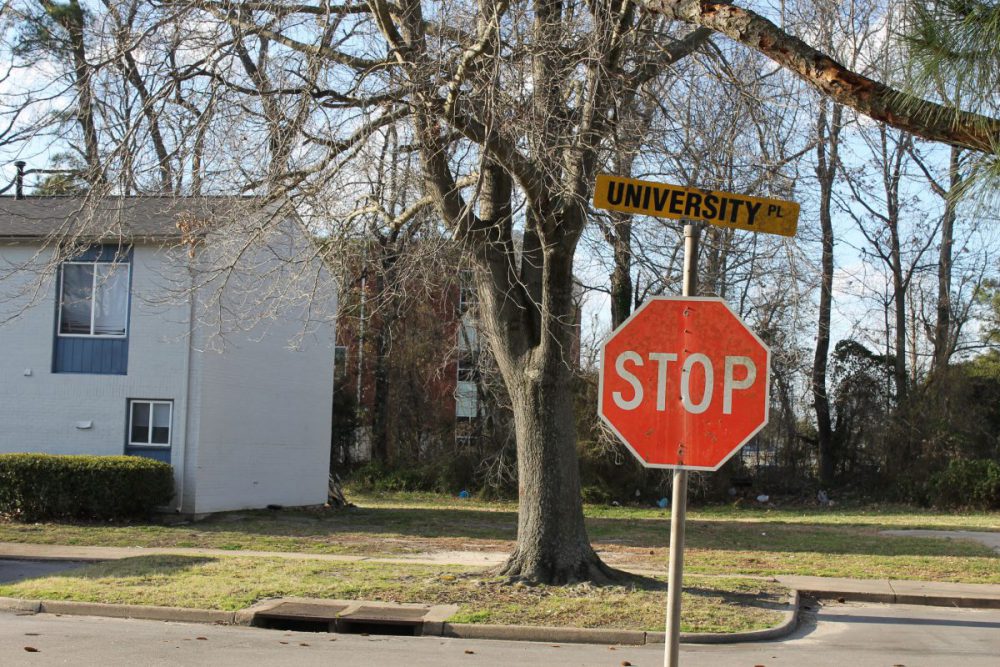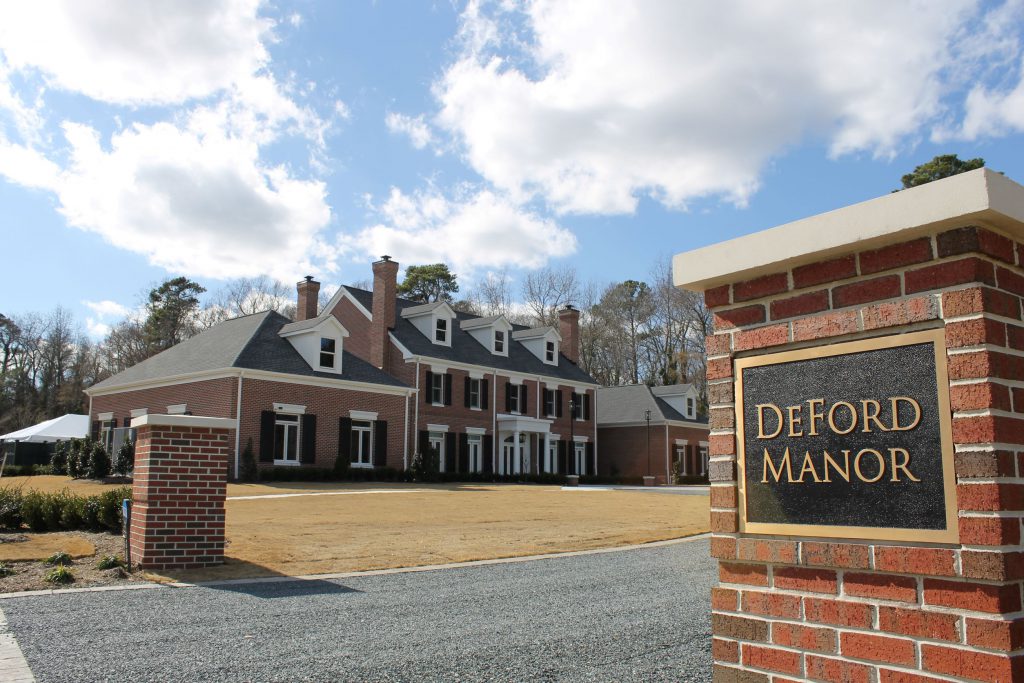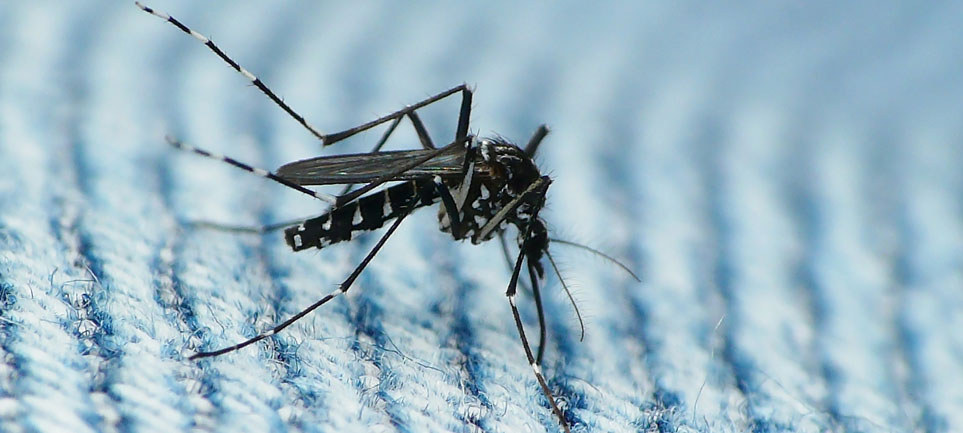Featured Image: A shooting occurred adjacent to campus behind the Chesapeake Bay Academy building on Thursday, Feb. 16.
Ross Winner | Marlin Chronicle
A nearby shooting on Thursday, Feb. 16 frightened campus and led to calls for clarification regarding LiveSafe, security protocols.
A shooting occurred near campus on Thursday, Feb. 16 shortly after 5 p.m., which caused student-athletes at their practices to immediately pause practice and run to seek shelter. Confusion and fear grew on campus due to a delayed LiveSafe message from campus officials.
A Virginia Beach Police Department tweet at 5:39 p.m. said, “VBPD is investigating a call that came in at 5:11 p.m. for a shooting in the 5700 block of University Place. One victim, conscious & breathing, has been transported to a local hospital. No suspects in custody. No further information available at this time.”
At 5:44 p.m., there was a LiveSafe notification with a broadcast message sent via the app as well as an email that said, “disregard notification, no threat to campus off campus incident.”
LiveSafe is a mobile app that is free and voluntary that only requires a VWU email address to register. The information on this app comes directly from the VWU Campus Security Department. Students, faculty and staff are strongly encouraged to have the app so they can receive text, email and push notifications in the event of an emergency scenario.
At 6:01 p.m., an email from Senior Vice President Keith Moore said, “Earlier this evening, University officials were notified of a possible threat adjacent to campus. After investigating, it was believed that given the proximity to Broyles Field it was best to have community members shelter in place.”
Moore added, “However, in the process of sounding the siren and sending notification, it was learned that the threat had been mitigated, which prompted the LiveSafe message to disregard.”
In an interview with the Chronicle, Moore recounted the situation and said the VBPD gave a courtesy call to the security gate on campus that there was an incident off campus. The call initiated the decision by campus security to stop people from entering or leaving campus in an attempt to steer people away from Baker Rd.
“[Campus security] didn’t wait for direction. They went into our off-campus assessment process to determine if there was an actual threat to campus,” Moore said.
If there was an immediate campus threat, they would have immediately alerted the campus community. In this case, they investigated the legitimacy of it first. The administration also wanted to have a full understanding of the situation before giving directions.
“Until we determine that there is cause for concern, we don’t want to cause concern,” Moore said.
The administration decided to side with caution knowing that there was no suspect in custody and that it was close to campus. This led to the sounding of the siren, which is one of two parts of the alert system. The other part is messaging, which was delayed.
“No sooner did we start the alert process, we received better information and that was two words: no threat,” Moore said. “We needed to pivot the messaging that went out.”
A tailored message was ready to go out about seeking shelter but it was changed to the message that was ultimately sent out, stating that there was no threat. The administration was told ‘no threat’ by a lieutenant in the VBPD.
Moore explained how VWU was one of the first universities in the commonwealth to adopt a messaging alert system after the 2007 Virginia Tech shooting which led to the usage of the LiveSafe system.
There is a LiveSafe dashboard at the front gate and reports can come in from any campus member, which show up on a map. This alerts campus security as well as Moore, Associate Vice President for Campus Life and Operational Management Jason Seward, Director of Residence Life David Steubing and Assistant Director of Residence Life Elyse Rosen in the form of an email receipt in live time.
“I can see what comes in and it’s often at night: a lot of noise complaints. I’ll see a noise complaint and I don’t get concerned that much because I know someone will go check it out,” Moore said. “If there’s something of greater concern, I’ll call the gate and go ‘what’s up with that?’”
For notification logistics, there are pre-written messages such as one for a tornado warning as well as the ability to make custom notifications. Those alerts are made in conjunction with campus security and administration.
Regarding the athletics response to the situation, Moore said they reacted “absolutely spot on” because they practiced sound situational awareness.
“If you detect a concern or something that could be considered a threat, you vacate. That’s exactly what they did. Coaches left the field, players left their equipment and along the way, they even notified the Women’s Lacrosse team,” Moore said.
Hearing the shot fired, seeing the VBPD update, reading news reports, hearing the campus siren and receiving campus alerts left people confused and scared.
Junior Zion Spearman, a member of the Baseball Team, was standing at home plate at practice when he heard the shots but did not know what was going on.
“We saw the Softball team sprint from the field all the way inside and then their head coach was like ‘guys, you got to run!’” Spearman said. “We left everything at the field to run inside and then coach emphasized to stay in Batten.”
After reflecting on this experience, Spearman still feels safe on campus due to the fact this was an off-campus occurrence and the university cannot control what goes on outside.
Freshman Jonas Juetz, a player on the Men’s Tennis team, was at practice when he saw the baseball and softball players running through the parking lot behind the tennis courts to enter the Jane P. Batten Student Center.
“We were just wondering ‘what’s happening?’ and then the coach from softball started shouting like 10 to 15 times but we didn’t identify that it was him until we heard ‘shooting, go in!’” Juetz said. Then, Juetz and his teammates ran from the court to get inside.
Juetz got information from the baseball and softball players but believes if there is a shooting, information should come directly from the university.
“The LiveSafe notification was way too late. Before the LiveSafe came in, our group chats were full of ‘Guys, take care.’ I feel like that definitely has to be handled better next time,” Juetz said.
At the time, he did not fully realize what was happening and did not have any other thoughts except to grab his stuff and run.
“It’s overwhelming, but I feel like the pain would have been bigger if I would have heard the gunshots,” Juetz said. “There was no thinking. There was just acting and adrenaline.”
Senior Brooke Morris, a Women’s Lacrosse player, was at practice when she heard multiple shots and the sirens of the first responders.
“When we heard the shots, one of my coaches made the remark that they sounded really close,” Morris said. “But given our school’s proximity to Norfolk, we brushed it off because we hear gunshots relatively frequently.”
Then, the athletic trainer got a call and told the assistant coach that everyone needed to seek shelter immediately. The lacrosse team left most of their equipment on the field and ran to the locker room in Trinder Center.
“In the short run from Birdsong to Trinder, I thought about the headlines I had read about the Michigan shooting. I felt worried for all of my friends who were not with me. I was fearful of what could unfold in the coming minutes,” Morris said.
They were told to stay in the locker room while the coach communicated with others to make sure all athletes were inside. During this time, Morris texted her friends to ensure they were in safe places but found out none of them knew there was any potential threat.
Additionally, Morris stated that she had been in the locker room for nearly ten minutes before the LiveSafe siren went off. She believes that it came far too late because if the threat breached campus, only those on Broyles and Birdsong fields would have been aware.
Morris found the follow-up email sent by Moore after 6 p.m. disappointing.
“There was no disclosure of what happened near campus. What does the threat being ‘mitigated’ mean? That the shooter was caught? That the shooter is far from campus? That it was a false alarm?” Morris said. “This campus is full of adults who have the right to know what may threaten them at the institution they pay to attend.”
Morris was also alarmed by how it seemed campus security had a lack of urgency to alert the campus of this threat.
According to Morris, this incident has not been forgotten by those who were on the fields that day and she doubts she will ever be able to forget how she felt when she ran into the locker room.
Sophomore Erin Andrews was in the Monumental Chapel and Beazley Recital Hall for Vox Vera rehearsal when she first heard of a potential campus threat. She heard the news from another student that said everyone was supposed to be on lockdown even though there was no direct communication from the university at that point. Then, she saw the VBPD tweet that explained the incident.
“I am really grateful for how Dr. Mortensen handled it. We had the keys to the chapel, so he locked all the doors,” Andrews said. “I know where the key to the upstairs music library is kept, so I got that and we went upstairs and sheltered in place.”
Andrews still feels safe on campus but believes the situation could have been handled better, especially with communication.
“I’m sure that there are all kinds of folks involved in making a decision like this and I understand that. My understanding is that as time went on, they set off the sirens and then realized they didn’t need to, but we were all kind of left in the dark,” Andrews said. “I hope that we can learn from this experience that we may not be as prepared as we think we are.”
Sophomore Emma Lankford first heard about the shooting from her roommate who saw it in the news. “My friends were in a panic and none of us knew what was going on, and not hearing anything from the school directly added to my anxiety surrounding the situation,” Lankford said.
She was in the Boyd Dining Hall at the time and felt a sense of panic as she saw those in choir sprint upstairs in the Monumental Chapel. “I thought something was seriously wrong and felt scared for the students out in the open who knew nothing because they didn’t have a friend who told them as I did,” Lankford said.
She also believes VWU handled the situation poorly because of the lack of a timely notification of a potential campus threat. Lankford felt unsafe because she did not know a protocol or idea of what to do.
The LiveSafe message at 5:44 p.m. that stated there was no threat made her reaction feel invalidated because of the situation being so close to campus. “This occurrence does not make me feel safe in school,” Lankford said. “Seeing the chaos erupt with no instruction or warning from the school until after the fact is scary to me.”
This shooting made her realize that they can occur at any time, anywhere.
“Seeing the tragedy of the recent college campus shootings, then experiencing the anxiety that our school could be next, makes me extremely cautious and alert at all times,” Lankford said.
Recently, VWU held an Active Threat Presentation with the Federal Bureau of Investigation Norfolk Branch on Thursday, Feb. 9 for students, staff and faculty. This event focused on situational awareness, see something, say something and run, hide and fight. Moore said there will be another FBI training in the fall.
The stress of this situation was elevated due to the Michigan State University shooting happening three days prior on Monday, Feb. 13, when three students were killed and five others were injured by a gunman who also fatally shot himself.
By Connor Merk
ccmerk@vwu.edu


